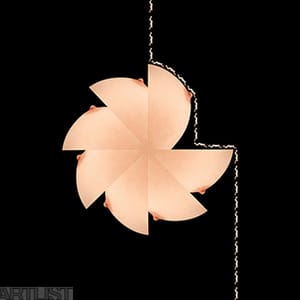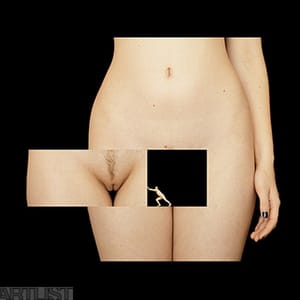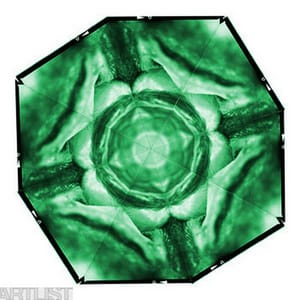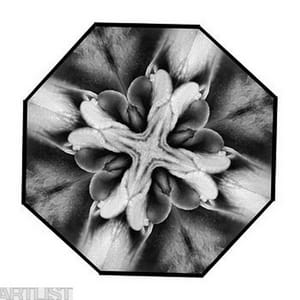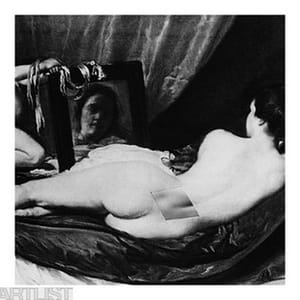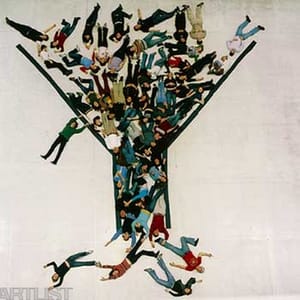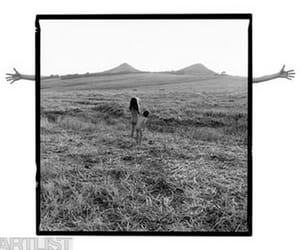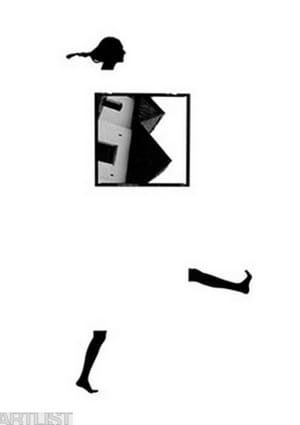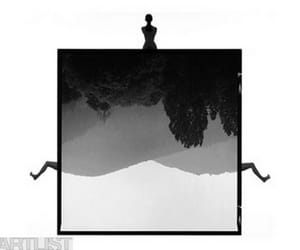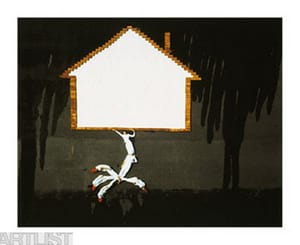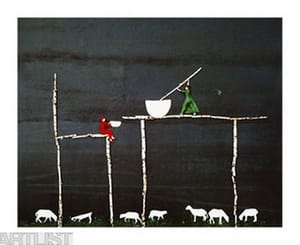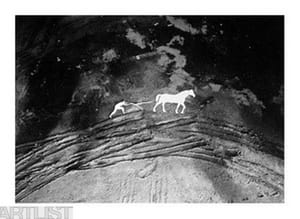- First Name
- Miro
- Surname
- Švolík
- Born
- 1960
- Birth place
- Zlaté Moravce, Slovensko
- Place of work
- Praha a Bratislava
- Website
- www.mirosvolik.cz
- CSU Library
- ↳ Find in the catalogue
About artist
After completing his studies at the Secondary School of Applied Arts in Bratislava where he specialised in applied photography (under the tutelage among others of Milota Havránková), Miro Švolík relocated to Prague. During his studies at the Academy of Performing Arts in Prague he joined a group of artists of his own age known as the Slovak New Wave (other members included Rudo Prekop, Vasil Stanko, Tono Stano, Kamil Varga and Peter Župník). He remained active on the Czech photographic scene both after completing his studies, when he was one of the founders of the Prague House of Photography (1991–97), and after the dissolution of Czechoslovakia. Since 2009 he has been head of the creative photography studio at the Academy of Fine Arts and Design in Bratislava.
His work is located on the boundary between applied/advertising arts and free/fine art and reveals several interests that Švolík has gradually refined and transformed. The most important subject matter of his work from the mid-1990s onwards is the female nude and fragments of the female body. “Unlike Stano’s photography [Tono Stano is an art photographer living and working in Prague], Švolík’s work is not sensually sexual, and unlike Stanko [Vasil Stanko, a Slovak photography], who is in certain respects almost brutal, Švolík has a sense of humour and playful eroticism,” writes Václav Macek in a comparison with Švolík’s confrères in the Slovak New Wave. From the 1980s onwards, Švolík’s erotic sense of humour moves away from displaying both man and women and focuses exclusively on the female form. Nevertheless, the photographer cannot be denied a knowledge of and a certain enchantment with female curves (as in the series Charles Baudelaire, Flowers of Evil, 2011, or History of Art, 2001, where he replaces the individual body parts of the paintings of Old Masters with his own photography), whereas other works seem almost empty, balanced on the boundary of a naive playfulness and mild obscenity (e.g. the series Stopařky / Female Hitchhikers, 2008). Inasmuch as in one case we can speak of a poetics of corporeality, such as is found in the kaleidoscopic depictions of clitorises (Květiny slasti / Flowers of Delight, 2004), the second language is closer to that of soft-porn. This approach, very popular amongst artists during the 1990s, has been laid to rest after 2000. The exclusive, and from today’s perspective uncritical utilisation of the woman as object was also common. Švolík’s skill, however, perhaps resides in the politically incorrect, which when looked at within the framework of the canon of high art provokes feelings of disapproval and slight disgust.
There are several reasons why Švolík is referred to as a postmodern photographer. Firstly, his work operates on the boundary of commercial or applied photography and fine art, which since the very origins of photography as a medium are two ineluctably linked worlds. Discussions on their division and how they should be referred to only began in Czechoslovakia as Švolík was beginning his career. Secondly, Švolík never hesitates to work with both simple and sophisticated references to the history of art and photography. Both the series mentioned above, History of Art and Flowers of Delight, are good examples of this. However, this does not prevent him from combining mediums and genres. Typical of his work as a member of the Slovak New Wave is a flirtation with arrangement and theatricality. Theatre is one of the central features of his photographs, for which the stage creates a structure within a structure. A certain grandiloquence is then shared with period animation and the embedding of many scenes in a traditionally bucolic setting (a technique also used by filmmaker Jan Švankmajer).
Švolík often constructs his images on historical foundations and this recalls parallels clear at the start of his career. He would create photographic scenes over large areas that he subsequently shot from a great height, in this way achieving a flatness and painterly or collage-like effect. The underlay of scenes, often concrete, asphalt, grass or pavements, forms the backdrop to a narrative and yet has its own significance. The photographer might have been inspired by the generation before him or artists working with found objects in informal casts and the remains of asphalt, such as Emila Medková or Vilém Reichmann. However, Švolík smoothes out these harsh structures with a simple symbolism of the tableau being played out within them (Môj život člověka / My Life of Man, 1986, or To My Native Land, 1986, and many others from the 1980s), or with almost fairytale themes. He also draws on fairytale motifs in his colour photography from 1987.
The symbols and pictograms that in the eighties occupied such a wide field of view from above the structures depicted gradually begin to take on their own life and become independent figures within Švolík’s collages, photograms and photographs. An obvious path led to art for CD and LP sleeves. Several pictograms were transformed into the frame of an entire photograph. Here we see evidence of Švolík’s irony, for instance in the cycle Back to Nature, 1992–97, in which nature is framed and supplemented by silhouettes of man. Natural formations are thus framed by these add-ons in the same way that human forms might resemble geological and botanical forms. Švolík has played with the similarity of shape that sees the peaks of roofs become breasts and hillocks shaped like plump buttocks all of his creative life. The naivety and simplicity dangerously bordering on banality, and the playfulness associated with provocation and teasing, represent ongoing creative principles for Miro Švolík.
- Author of the annotation
- Tereza Hrušková
- Published
- 2017
CV
Studium:
1981–1987 FAMU, katedra umělecké fotografie, Praha 1975–1979 Střední umělecko-průmyslová škola, obor užité fotografie, Bratislava Stáže, tvůrčí pobyty:
1998 Cité International des Arts, Paříž
1991
Projects UK, Newcastle Ocenění:
1992 Najkrajšie knihy Slovenska, Cena Ministerstva kultúry SR za knihu Jedno telo jedna duša, Bretislava 1990 Young Photographers, Cena od International Center of Photography, New York City 1989 KODAK Triennale Preis, 1. Internationale Foto-Trienale, Esslingen
Exhibitions
- Solo exhibitions
-
2005
Cesta do středu, Radniční výstavní síň, České Budějovice
2002
Otvory a DÍRY, Ateliér Josefa Sudka, Praha
Openings and HOLES, MuseumQuartier Wien - Quartier21, Vídeň
2001
Histoire de voir, Musée Pierre Noel, Sant-Dié-des-Vosges
1998
Europa 98, Brigittines, Brusel
1997
Miro Švolík z Kozároviec, Tatranská galéria, Dom fotografie, Poprad
1996
Family Album, Stuart Levy Fine Art, New York City
5,6 m2 na osobu, PHP (Pražský dům fotografie), Praha
1992
Galerie Stará radnice, Brno
Jedno telo jedna duša, SNG, Bratislava
Les contes de la Slovaquie, Occurrence, Montreal
1991
Galerie G4, Cheb
Zone Gallery, Newcastle
1988
Fotografie Forum Frankfurt, Frankfurt nad Mohanem
Robert Koch Gallery, San Francisco
Moje življenje človeka, Mala fotografska galerija, Ljubljana
1986
Galerija fotografija, Split
1985
Archiv Tošo Dabac, Záhřeb
- Group exhibitions not included in ARTLIST.
-
2013–2014
Slovenská nová vlna, 80. léta, Dům fotografie, Praha
2012
Element F. Fotografie a umění ve druhé polovině 20. století, Pražákův palác, Brno
2009
Tschechische Fotografie des 20. Jahrhunderts, Kunst- und Ausstellungshalle der Bundesrepublik Deutschland, Bonn
2007
Moderní a poválečné umění. Současné umění. Fotografie, Galerie Louvre, Praha
2006
Portfolia 1989-1996 z kolekcji Jiřego Hankego, Galeria Parter, Kłodzko
2005
Česká fotografie 20. století / Czech photography of the 20th century, Praha
2002
Česká a slovenská fotografie 80. a 90. let 20. století, Muzeum umění Olomouc - Muzeum moderního umění, Olomouc
1997
Jistoty a hledání v české fotografii 90. let, Umelecká beseda slovenská, Bratislava
Jistoty a hledání v české fotografii 90. let, Dům umění města Brna, Brno
Pražský dům fotografie, Pražský dům fotografie (1991-1997), Praha
1994
Czech and Slovak Photography from Between the Wars to the Present, Boston Public Library, Boston
Po sametové revoluci: Současná česká a slovenská fotografie / After the Velvet Revolution: Contemporary Czech and Slovak Photography, Photography Gallery of Western Australia, Perth
1993
Medzi obrazom a viziou, Veľvyslanectvo Slovenské republiky, Berlín
1991
Slovenská inscenovaná fotografia, Stockholm
1989
37 fotografů na Chmelnici, Junior klub Na chmelnici, Praha
1989
Československá fotografie 1945 - 1989, Valdštejnská jízdárna, Praha
1988
11, Výstavní síň Fotochema, Praha
1987
Aktuální fotografie 2 - Okamžik, Galerie 4 - Galerie fotografie, Cheb
1986
V čase, Výstavní síň Fotochema, Praha
- Collections
- Allan Chasanoff Collection International Center of Photography, New York City Moravská galerie v Brně, Brno Musée de l'Elysée Lausanne, Lausanne Severočeské muzeum, Liberec Slovenská národná galéria, Bratislava The Art Institute of Chicago, Chicago, Illinois The Museum of Modern Art (MoMA), New York City Uměleckoprůmyslové museum, Praha
Monography
- Monography
Monografie: 2006 Miro Švolík, Cesta do středu 1992 Miro Švolík Zastoupení v kolektivním katalogu: 2015 Srdceráj 2012 Element F. (Fotografie a umění ve druhé polovině 20. století) 2011 V plném spektru (Fotografie 1841 - 2005 ze sbírky Moravské galerie v Brně), 2009 Tschechische Fotografie des 20. Jahrhunderts 2002 Česká a slovenská fotografie osmdesátých a devadesátých let 20. století 1996 Jistoty a hledání v české fotografii 90. let / Certainty and Searching in Czech Photography of the 1990s 1991 Současná československá Fotografie 1989 37 fotografů na Chmelnici 1988 11 1987 Aktuální fotografie 2 (Okamžik) 1985 27 Contemporary Photographers from Czechoslovakia
- Articles
Birgus Vladimír: Česká a slovenská fotografie 80. let, Česká a slovenská fotografie dnes, 1991, s.17.
Prekop Rudo , Švolík Miro , Stano Tono , Chwastowiczová Izabella , Slovenská vlna z Prahy, Labyrint revue, 9 - 10,1994, s.52-53.
Macek Václav: Slovenská inscenovaná fotografia, Listy o fotografii, 2, 1998, s.37-37.
Macek Václav , Medzi obrazom a viziou, Listy o fotografii, 2,1998, s. 37-37

